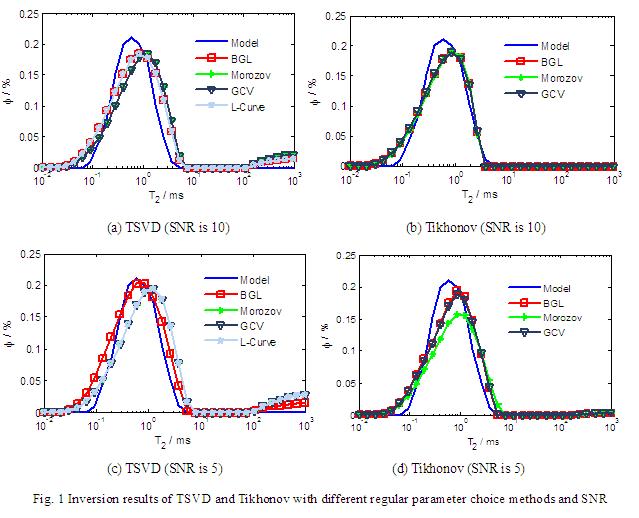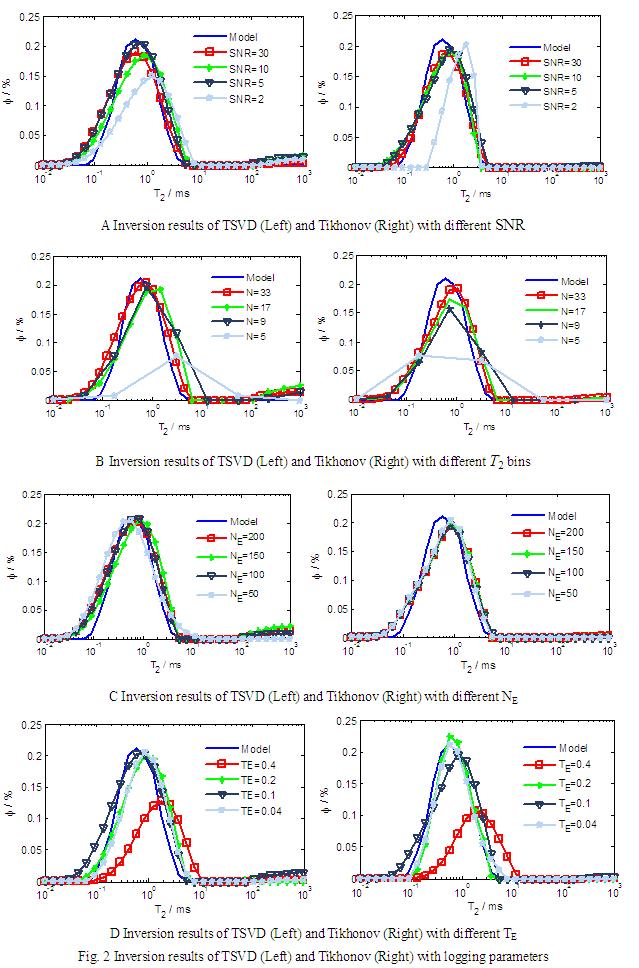NMR logging Inversion Methods and Influence Factor Analysis in Shale Reservoirs
- 1. State Key Laboratory of Petroleum Resource and Prospecting, China University of Petroleum, Beijing, China
- 2. College of Science, China University of Petroleum, Beijing, China
NMR logging is a powerful detection method both in conventional and unconventional reservoirs. But in shale reservoirs, due to the low porosity and very low permeability, the signal to noise ratio (SNR) is very low. Usually the SNR is less than 10, and sometimes less than 5. And due to the nanometer pore size, the surface relaxation is very strong. Hence, the echo train decays very fast. Therefore, it is necessary to verify whether the usual inversion methods and the choices of the regular parameters are suited to shale reservoirs. In this article, two inversion methods TSVD and Tikhonov are researched, which include four kinds of regular parameter choices (i.e. BGL, Morozov, GCV and L-curve). And SIRT method is used to realize non-negative restriction. Numerical simulations show that both TSVD and Tikhonov methods with all the four regular parameter choice methods are suited to shale reservoirs when SNR is 10. When SNR is 5, for TSVD method, BGL is the best. BGL and GCV are suited to Tikhonov method while the other two are not when SNR is 5. Tikhonov method is better than TSVD in shale reservoirs, especially when SNR is low. The inversion results are shown in Fig. 1.

In this article, we also analyze the effects of SNR, the number of T2 bins, the number of echoes and the echo space TE. The inversion results are shown in Fig. 2.

Keywords NMR logging; Shale reservoirs; Inversion method; Regular parameter choice; Influence factor analysis
- [1] Coates G R, Xiao L Z, Prammer M G., (1999), NMR Logging Principles and Applications, Texas: Gulf Publishing Company
- [2] Xiao L Z., (1998), NMR Image Logging and NMR in Rock Experiments, Beijing: Science Press
- [3] Dunn K J, Xie R H., (2010), NMR logging Principle and Applications, Dongying Shandong: China University of Petroleum Press
- [4] Jiang R Z, Yao Y P, (2005), Improved Algorithm for Singular Value Decomposition Inversion of T2 Spectrum in Nuclear Magnetic Resonance, ACTA PETROL SINICA, 57-59
- [5] XIAO L Z, Zhang H. R, LIAO G Z, et al, (2012), Inversion of NMR relaxation in porous media based on Backus-Gilbert theory, Chinese J. Geophys, 3821-3828
- [6] Tikhonov A N, (1963), olution of incorrectly formulated problems and the regularization method, Soviet Math, 1035-1038
- [7] Liao G Z, Xiao L Z, Xie R H, et al, (2007), Influence Factors of Multi-exponential Inversion of NMR Relaxation Measurement in Porous Media, Chinese J. Geophys, 932-938
